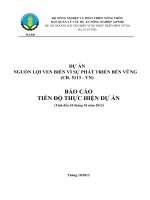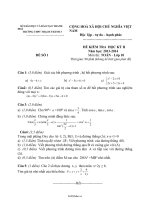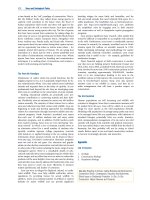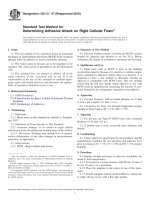- Trang chủ >>
- Đề thi >>
- Đề thi lớp 1
5113
Bạn đang xem bản rút gọn của tài liệu. Xem và tải ngay bản đầy đủ của tài liệu tại đây (655.41 KB, 14 trang )
Vũ Quốc Thông (PhD.)
10/10/2020
Chapter 8
Inventories
Vũ Quốc Thông (PhD.)
Objectives
Compute the cost of inventory under the
periodic and perpetual inventory system,
using the FIFO,LIFO and Weighted
average cost methods
Compare and contrast the use of the three
inventory costing methods
2
1
Vũ Quốc Thông (PhD.)
10/10/2020
Contents
Inventory cost flow assumptions
Periodic and perpetual inventory system
Inventory costing methods under the
periodic inventory system
Inventory costing methods under the
perpetual inventory system
Effect on P/L and B/S
Which costing method to choose from?
3
Inventory cost flow assumptions
Business may buys identical units of
goods at different unit costs
Cost flow must be assumed.
First in, first out (FIFO)
Last in, first out (LIFO)
Weighted Average
E.g?
4
2
Vũ Quốc Thông (PhD.)
10/10/2020
First in, first out
5
Last in, first out
6
3
Vũ Quốc Thông (PhD.)
10/10/2020
7
Weighted Average
8
4
Vũ Quốc Thông (PhD.)
10/10/2020
Periodic and perpetual inventory
systems
Perpetual inventory system: Each
purchase and sale of goods is recorded in
an Inventory account.
Periodic inventory system: Inventory is
accounted for at the end of the period.
(what types of business using…?)
9
Periodic and perpetual inventory
systems
Remember !
Perpetual
inventory
system
Closing Balance = Opening
Balance + Purchase - Sale
Periodic
inventory
system
COGS = Opening Balance +
Purchase – Closing Balance
10
5
Vũ Quốc Thông (PhD.)
10/10/2020
Inventory Costing Methods under
the perpetual inventory system
Using one of the following cost flow
assumptions:
FIFO;
LIFO;
and Weighted Average Cost method
Also, stock card or inventory subsidiary
ledger account are used in determining the
inventory’s ending balance and value.
11
Inventory Costing Methods under
the perpetual inventory system
FIFO
Example
Date
Units
1st Jan
Beginning Bal 300
2nd Jan
Sale
200
4th
Purchase
900
5th Jan
Sale
500
8th
Sale
300
Purchase
400
Jan
Jan
30th Jan
Cost per Unit
$10
$12
$14
12
6
Vũ Quốc Thông (PhD.)
10/10/2020
Inventory Costing Methods under
the perpetual inventory system
FIFO
Ending Inventory?
Quantity =
Value = $
Units
COGS = $
13
Inventory Costing Methods under
the perpetual inventory system
LIFO
Example
Date
Units
1st Jan
Beginning Bal 300
2nd Jan
Sale
200
4th
Purchase
900
5th Jan
Sale
500
8th
Sale
300
Purchase
400
Jan
Jan
30th Jan
Cost per Unit
$10
$12
$14
14
7
Vũ Quốc Thông (PhD.)
10/10/2020
Inventory Costing Methods under
the perpetual inventory system
LIFO
Ending Inventory?
Quantity =
Value = $
Units
COGS = $
15
Inventory Costing Methods under
the perpetual inventory system
Weighted Average cost method
Example
Date
Units
1st Jan
Beginning Bal 300
2nd Jan
Sale
200
4th
Purchase
900
5th Jan
Sale
500
8th
Sale
300
Purchase
400
Jan
Jan
30th Jan
Cost per Unit
$10
$12
$14
16
8
Vũ Quốc Thông (PhD.)
10/10/2020
Inventory Costing Methods under
the perpetual inventory system
Weighted Average cost method
Ending Inventory?
Quantity =
Value = $
Units
COGS = $
17
Inventory costing methods under
the periodic inventory system
Using one of the following cost flow
assumptions:
FIFO;
LIFO;
and Weighted Average Cost method
18
9
Vũ Quốc Thông (PhD.)
10/10/2020
Inventory Costing Methods under
the periodic inventory system
FIFO
Example:
Date
Units
Cost per Unit
1st Jan
Beginning Bal 300
$10
2nd Jan
Purchase
400
$12
5th
Purchase
600
$14
20th Jan
Purchase
200
$10
31st
Closing Bal
400
Unknown
Jan
Jan
19
Inventory Costing Methods under
the periodic inventory system
Under FIFO method, the goods purchased
first are sold first. Therefore:
Ending inventory: 400 units would comprise:
200 units
purchased on
20th Jan (@$10
per unit)
200 units
purchased on
5th Jan (@$14
per unit)
Inventory Closing
Balance = $4,800
20
10
Vũ Quốc Thông (PhD.)
10/10/2020
Inventory Costing Methods under
the periodic inventory system
LIFO
Example:
Date
Units
Cost per Unit
1st Jan
Beginning Bal 300
$10
2nd Jan
Purchase
400
$12
5th
Purchase
600
$14
20th Jan
Purchase
200
$10
31st
Closing Bal
400
Unknown
Jan
Jan
21
Inventory Costing Methods under
the periodic inventory system
Under LIFO method, the goods purchased
last are sold first. Therefore:
Ending inventory: 400 units would comprise:
300 units of
Beginning Bal
1st Jan (@$10
per unit)
100 units
purchased on
2nd Jan (@$12
per unit)
Inventory Closing
Balance = $4,200
22
11
Vũ Quốc Thông (PhD.)
10/10/2020
Inventory Costing Methods under
the periodic inventory system
Weighted Average cost method
Example:
Date
Units
Cost per Unit
1st Jan
Beginning Bal 300
$10
2nd Jan
Purchase
400
$12
5th
Purchase
600
$14
20th Jan
Purchase
200
$10
31st
Closing Bal
400
Unkown
Jan
Jan
23
Inventory Costing Methods under
the periodic inventory system
Weighted Average unit cost =
= (3,000 + 4,800 + 8,400 + 2,000)/
(300 + 400 + 600 +200)
= $12.13
Ending inventory= 400 * 12.13 = $4,852
24
12
Vũ Quốc Thông (PhD.)
10/10/2020
Effect on P/L and B/S
Whatever the cost method apply, it will affect
both P/L and B/S results as it impacts on:
COGS
Inventory ending balance
25
Which costing method to choose
from?
It depends on company’s policy
LIFO is not permitted in a number of
countries
This is an accounting policy, therefore, it
requires a consistency
26
13
Vũ Quốc Thông (PhD.)
10/10/2020
Which costing method to choose
from?
During a period of inflation or rising price,
applying FIFO would give a higher gross
profit and higher ending inventory balance
as compared with the other two methods.
27
Homework for Ch.8
Problem (p.353 – 354)
Matching (p. 355, exclude: E. & F.)
Multiple choice (p. 355)
Refer:
/>
28
14








